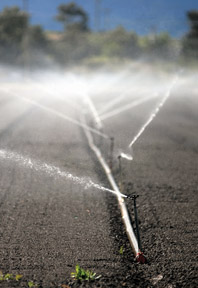Yearly allocation improves, though restrictions remain due to
smelt
Improving water conditions in the state mean that San Benito
County farmers and ranchers will receive more water from the
Central Valley Project, reducing
– but not eliminating – the need to draw water from local
aquifers.
The San Benito County Water District expects to receive 25
percent of its contract for ag water, compared with the 10 percent
allocation it received last year.
Yearly allocation improves, though restrictions remain due to smelt
Improving water conditions in the state mean that San Benito County farmers and ranchers will receive more water from the Central Valley Project, reducing – but not eliminating – the need to draw water from local aquifers.
The San Benito County Water District expects to receive 25 percent of its contract for ag water, compared with the 10 percent allocation it received last year.
“It will mean there will be less groundwater pumping,” said Jeff Cattaneo, the water district’s executive director. “Because the quality of water is so significant [in the CVP water compared to local groundwater] the long-term impacts it’ll have include less salt build-up in soil and farmers will be able to grow more crops that are salt-sensitive, if they choose to. Typically, yields are higher with the higher quality water.”
This week’s sporadic rains were a continuation of a fairly wet winter that has raised storage in local reservoirs “significantly,” according to Cattaneo.
“We’re at about 50 percent in Paicines and I’d expect that Hernandez is about three-quarters full, if not more,” he said, noting that new measurements were expected to be taken mid-week. “Seventy-five percent storage in Hernandez would be about 12,000 to 13,000 acre-feet, which is significantly more than we started out with last year, when we had 6,000 acre-feet.”
An acre-foot of water is equal to 325,851 gallons.
“All things considered, it’s looking better,” Cattaneo said. “This week there has been more rain and snow around Shasta and the Sierras, so it all looks good. Surface water conditions can change dramatically from year to year, but groundwater storage takes longer to affect a change.”
San Benito County’s groundwater basin is “in very, very good condition” in terms of capacity, he added, though the district’s plan is to continue not to over-use that resource.
“We want to, over the long period, manage the amount of water that we’re taking out of the basin so it matches the recharge to the basin so we’re not effectively mining groundwater,” Cattaneo said. “We want to maintain and manage that resource into the future for everybody.”
The water district sells Central Valley Project water at roughly $140 per acre-foot, counting delivery and power charges, whereas pumping from an individual well would cost a farmer approximately $110 to $120 per acre-foot.
However, the piped-in water from the district is delivered through pipes at a pressure that meets the requirements of irrigation systems, so many customers prefer to use that rather than drawing lower-quality water from their own wells.
A great unknown in the state’s yearly water allocations are the restrictions on pumping from the Sacramento Delta because of the endangered Delta smelt.
“The biggest issue we’ve got is not so much the physical volume of water; it’s whether the triggers for the biological opinions [of how water pumping affects the fish population] come into play and they have to restrict pumping,” Catteneo said.
For example, if more than 120 smelt were taken into water pumps between January through March 31, pumping would have to be reduced significantly.
“We were able to avoid that this year, which was fortunate for all of us,” Cattaneo said. “We’re going to have to wait and see what the weather does and what the (Obama) administration does with the biological opinions and how those are managed. All of the contractors are trying to get the Bureau of Reclamation to operate at a higher range instead of the most conservative in order to increase the water supply. It’s going to be an ongoing process. We’re working through the legal challenges to the biological opinions and working through the political side with the administration.”
After three years of drought, Cattaneo said the recent rain doesn’t necessarily mean an end to the water shortage, “but given the rainfall this year, we’re certainly not in a physical drought this year.”
“There’s still a lot of make-ups for the last three years,” he said. “There are still reservoirs in the state that are significantly below where they should be.”
And in those that appear to be near capacity, he said, looks can be deceiving.
“San Luis Reservoir is looking pretty good. It could be deceiving if you drive by it, because a significant amount of the water in there right now was carryover from last year and is already purchased and belongs to contractors and customers, so it can’t be allocated to this year’s requests.”










